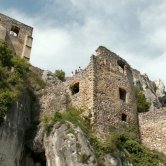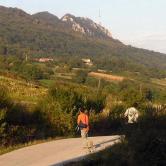Sights > Veliki and Mali Kalnik
There are no written records of the foundation of the fortresses of Veliki and Mali Kalnik. The earliest mention of Mali Kalnik dates from 1217, while Veliki Kalnik was first mentioned in written records only in 1243, but historian Gjuro Szabo has some doubts about the authenticity of these records. Still, one must bear in mind that the term castrum was not restricted to its current meaning of 'fortress', but was used in a wider context. On the other hand, Kalnik's strategic position must have made it a target of invaders so a citadel that could be defended from attack must have been built as early as possible. Szabo doesn't really support Kukuljević's thesis that the citadel was built in the period of Croatian rulers since some Romanesque characteristics could be seen in the upper part of the the hill top citadel. However, in the lower part one can see some characteristics of the 14th or 15th Gothic style. The remains of the Chapel of St Catherine are insufficient to provide some strong evidence of the establishment of the fortresses, though there is no mention of the Chapel in the early records.Outlining the history of Kalnik, Fran Gundrum of Oriovac writes: Spreading out from its bedrock core is the town of Kalnik, overlooking the picturesque hamlets on the gentle slopes, in some charters also called: Kamnik, Kemnik, Kamluk, Kemlek, Kevnik, Gemnich, Gemach.
According to a disputed charter of 1243, King Bela IV gave the town of Kalnik to brothers Filip and Deterik. If the Charter is authentic, Kalnik can be considered a fortress, since the phrase castrum nostrum Kemluk has a more restricted meaning than, for example, the phrase castri Crisiensis or castri de Rokonuk. Consequentially, this could be considered the first mention of the fortress, if we disregard a somewhat obscure mention in the phrase magnum montem ad castrum Gregorii. Regardless of the origins of the first clear mention of the fortress, one could still maintain that the fortresses dates from the period of Tartar Wars. In the charter of 1265 there is a mention of comes and iobago castri nostri de Kemluk. Since the charter was issued by the King, one can maintain that at that time Kalnik had still been the royal castrum. King Stephen gave Kalnik to banus Roland in 1270, which could be the basis for disputing the charter of 1243. In 1291, Kalnik was given to a Gudrun, and later on to the prefects (comes terrestris) of Veliki Kalnik.The smaller fortress of Mali Kalnik may have been surrounded by an oval perimeter wall. In the 20th century the castle was still standing on the hilltop, but today the site is marked by only a few stones.
The original architecture, if one can call it that, of Kalnik is diverse, and was subject to the landscape, rather than to the will of people. Upon its establishment, the urban settlement was dominated by a large, quadrangular tower, which may have been even taller than indicated by the remains that we can see today. The remains of the pillars support this thesis. In the lower part of the tower the windows are narrow, resembling little semicircular holes, while the upper part, probably intended to be used for dwelling purposes, may have contained large windows. Unfortunately, there are no remains of the upper part of the tower left today, but since it may have been used for dwelling purposes (the stone spiral stairs too exquisite for the military staff support this thesis) there must have been many Bohemian windows, fire place frames, doorway frames...One must bear in mind that Kalnik was home to many kings and queens. Near the tower there was another, somewhat elongated, building, which sat askew, as well as a defensive structure including smaller buildings with narrow streets, and the foundations of the palace chapel.
The front tower of Mali Kalnik has been preserved until recently. There are only a few records of this fortress, so we know that it was sometimes the possession of the same noble family as the fortress of Veliki Kalnik, and sometimes it was autonomous. Szabo indicates, without referring to the source of this mention, that in 1250 king Bela gave Mali Kalnik to Abraham and Nikola, the sons of the prefect of Moravice, to whom he also gave Rakovac in 1245.






